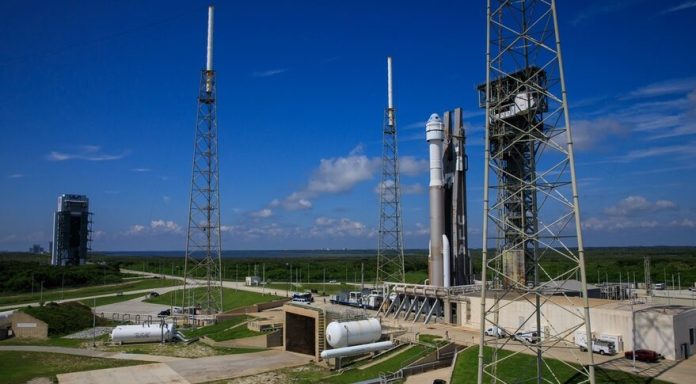
WASHINGTON — NASA and Boeing say they’re ready to make a second attempt to launch the company’s CST-100 Starliner spacecraft on an uncrewed test flight after an incident at the International Space Station called off the first attempt last week.
Starliner was scheduled to launch July 30, but a temporary loss of attitude control at the station July 29, caused by thruster firings of the Nauka module several hours after it docked with the station, led NASA to postpone the launch. “We want to ensure the space station is in a stable configuration and ready for Starliner to arrive,” Steve Stich, NASA commercial crew program manager, said at a July 29 briefing.
The next opportunity to launch Starliner was Aug. 3, assuming the station was able by then to support a docking. NASA announced late July 30 that they were proceeding with a launch that day, in an instantaneous launch window at 1:20 p.m. Eastern from Cape Canaveral Space Force Station. Weather forecasts project a 60% chance of acceptable weather for the launch.
A launch on Aug. 3 would set up Starliner for a docking attempt at 1:37 p.m. Eastern Aug. 4. Starliner would remain at the station until Aug. 9, undocking at 9:08 a.m. Eastern and landing at White Sands, New Mexico, about four hours later.
After the postponement of the first launch attempt, United Launch Alliance rolled the Atlas 5 rocket carrying Starliner back to its assembly building July 30 to protect the vehicle from the weather. The rocket is slated to roll back out to the pad Aug 2.
No other servicing of the spacecraft was planned before the next launch attempt. “Starliner and the Atlas are in a good configuration, and they can stay in the config they’re in for quite a number of [launch] opportunities,” Stich said.
While NASA confirmed plans for the next launch attempt, it’s said little about the incident with Nauka that caused the delay. There have been no other issues reported with the new module since its docking, and Russian cosmonauts Oleg Novitskiy and Pyotr Dubrov entered the module for the first time July 30.
Vladimir Solovyov, designer general of RSC Energia and flight director of the Russian segment of the ISS, said in a Roscosmos statement July 30 that the thruster firing was caused by a software problem. “Due to a short-term software failure, a direct command was mistakenly implemented to turn on the module’s engines for withdrawal, which led to some modification of the orientation of the complex as a whole,” he said.
Neither NASA nor Roscosmos have disclosed additional information about the problem and how they ensured it would not happen again. At the July 29 briefing, NASA officials played down the severity of the problem, which the agency originally said caused the station to drift 45 degrees out of its intended attitude.
“We have all sorts of contingency plans,” Joel Montalbano, NASA ISS program manager, said at the July 29 briefing. Station controllers “were seeing goodness come to us fairly quickly and we able to get us back to a stable attitude within the hour.”
However, the situation may have been more serious than what NASA originally claimed. Publicly available telemetry showed much greater excursions in roll, pitch and yaw during the hour it took to restore the station’s attitude.
“Reports of ISS only being 45 degrees out were premature,” Zebulon Scoville, a NASA ISS flight director, tweeted July 30. “We proceeded to do headstands and cartwheels. Olympic judges would be proud.”
– Advertisement –